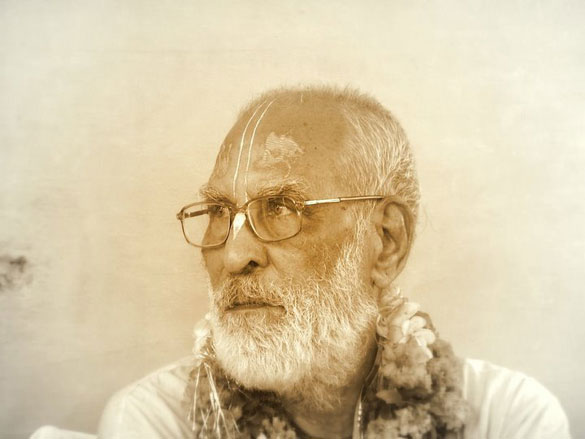 Sri Srimad Bhaktivedanta Narayana Gosvami Maharaja
Sri Srimad Bhaktivedanta Narayana Gosvami Maharaja
Devananda Gaudiya Matha: March 21, 2005
First of all I offer millions of obeisances to the lotus feet of my most worshipable Gurupada-padma, nitya-lila pravistha om visnupada Sri Srimad Bhakti Prajnana Kesava Gosvami Maharaja. Then my siksa-gurus, nitya-lila pravistha om visnupada Sri Srimad Bhaktivedanta Swami Maharaja, to Srila Bhaktivedanta Vamana Gosvami Maharaja and Srila Bhaktivedanta Trivikrama Maharaja. I offer millions of obeisances at their lotus feet. I also offer appropriate respects to my god-brothers, and to all the tridandipad sannyasis, Vaisnavas and Vaisnavis.
Today we are very fortunate. We have assembled in Navadvipa-dhama. This dhama (abode of the Lord, manifested in this world) is very remarkable, but not everyone can understand its glories. Fulfilling the desire of Srila Prabhupada Sarasvati Thakura, my Gurudeva established this Devananda Gaudiya Matha – replete with nine spires and the deity of Koladeva (Varahadeva). It is located in the very place in which the smarta-brahmanas who were opposed to Srila Prabhupada had made their headquarters.
Srila Prabodhananda Sarasvati reveals the secret of Navadvipa-dhama in his Navadvipa Satakam (verse 78):
aradhitam nava-vanam vraja-kananam te
naradhitam nava-vanam vraja eva dure
aradhito dvija-suto vraja-nagaras te
naradhito dvija-suto na taveha krsnah
Navadvipa-dhama is especially noteworthy for the confluence of five rivers – Panca-veni. If one dives into Panca-veni, one will surface in the Yamuna River at Kesi Ghata in Vrndavana. Gaurangera sangi gane, nitya-siddhe kori mane, se jaya vrajendra-suta pasa – and if one understands that Mahaprabhu’s associates are eternally perfect, one will attain the lotus feet of Vrajendra-nandana Syamasundara.
Yet, even though Navadvipa-dhama is non-different from Vrndavana, there is some speciality:
‘krsna-nama’ kare aparadhera vicara
krsna balile aparadhira na haya vikara
(Caitanya-caritamrta Adi 8.24)
“If someone will chant krsna-nama but at the same time commit the ten offenses, he will not experience melting of the heart and tears flowing from his eyes.” However:
gaura-nityanande nahi esaba vicara
nama laite prema dena, vahe asrudhara
(Caitanya-caritamrta Adi 8.31)
Gaura-nityananda-nama does not consider any offense. If someone chants their names, his heart will melt and tears will flow from his eyes. Thus, gaura-nama is more merciful than krsna-nama. Gaura-dhama also, for the same reason, is more merciful than Krsna-dhama, Vrndavana. Lord Indra, who had committed a grave offense to Sri Krsna, came to Navadvipa with Surabhi, and here Mahaprabhu completely forgave his offense. Indra had previously approached Sri Krsna in Vrndavana, but he had to come here to get full relief.
One may say he already knows Navadvipa-dhama and there is no need to hear anything further about it. Please don’t think like this. Its glories are very deep. To enter into the secrets of this dhama, we must discuss its many different aspects. We also pray to Navadvipa-dhama that it will reveal its profound glories to us.
Our goal is not Krsna. Love of Krsna and service to Krsna is our goal. If one has no love for Lord Sri Krsna’s lotus feet, one cannot serve Him. Kamsa and Jarasandha were both with Krsna, but they had no love and affection for Him. Thus they were unable to relish the bliss of service. So our goal is krsna-prema.
Krsna is the embodiment of all rasas – He is akhila-rasamrta-sindhu. Still, He had three desires that He could not fulfill. To fulfill them He had to take the sentiments and complexion of Srimati Radhika and appear in Navadvipa-dhama.
Who is Mahaprabhu? He is actually Sri Krsna, but very beautifully decorated with Radhika’s sentiments and complexion. This is Sacinandana Gaurahari. This is why He is golden – He has taken Her bhava and kanti (complexion).
There is a special consideration in understanding this very rare prema. It has two aspects –sambhoga (meeting) and vipralambha (separation). If you don’t understand both types of prema, you cannot understand Sri Caitanya Mahaprabhu and Navadvipa. Meeting and separation are further divided into millions of aspects, but four are prominent. There are four types of sambhoga: sanksipta (brief meeting), sankirna (contracted meeting), sampanna (successful meeting) – also called sampurna (complete) – and samrddhiman (fully flourishing meeting). These four types of meeting depend on four types of separation – purva raga, mana, kincid dura pravasa and sudura pravasa.
Sanksipta-sambhoga takes place only after purva-raga. Purva-raga is separation that is felt prior to one’s initial meeting. The second type of separation is called mana, separation due to a sulky or contrary mood. Meeting after mana is called sankirna-sambhoga. This meeting is somewhat contracted because, after giving up her anger, the heroine is happy to meet with her lover but she still remembers that he has met with someone else. Next is sampanna-sambhoga. This takes place after kincid dura pravasa – separation of a short distance. An example of sampanna-sambhoga is Krsna meeting with the gopis after returning from cow grazing, or Krsna appearing before the gopis after they sang Gopi-gita.
Last is samrddhimana-sambhoga. This takes place after sudura-pravasa, a very long and distant separation – when Krsna goes to Mathura and then to Dvaraka. The meeting of Sri Radha and Lord Krsna at Kuruksetra is samrddhimana-sambhoga, as well as Krsna’s meeting with the gopis when He finally returned from Dvaraka to Vraja-mandala. Sudura-pravasa – from a neutral point of view, this separation dances over the head of sambhoga. In sambhoga, outwardly there is meeting, but inwardly something is lost. At the time of separation, on the other hand, though outwardly there is no meeting, inwardly the meeting is complete and perfect, and many realizations occur which do not occur at the time of meeting. This is the speciality of vipralambha, from a neutral point of view.
If one wants to do bhajana in vipralambha, one must cry out like Mahaprabhu, who used to lament, “Alas! Alas! Where is the Lord of My life, Sri Krsna?” This sentiment should come in the heart. If there is no vipralambha, one cannot relish milana, meeting. In vipralambha (in the stage of mohanakhya mahabhava) there are many different astonishing anubhavas (internal feelings) – divyonmada (transcendental insanity), prajalpa, jalpa and eight other types of transcendentally maddened, raving speech.
However, despite the internal joy that comes in vipralambha, none of Srimati Radhika’s associates want separation. They always want Radha and Krsna to meet. To think that They aught to be separated is actually foolishness. Bhaktivinoda Thakura has said that no associates want separation, but from a neutral point of view it is clear that vipralambha has many wonderful aspects.
There is an astonishing pastime that takes place in meeting: Srimati Radhika is sitting on Sri Krsna’s lap at Prema Sarovara. A bumblebee (madhusudana) was flying around Radhika’s face and Madhumangala chased it away with a stick. He announced, “Madhusudana is gone and he will never return.” Because Madhusudana is also a name of Krsna, Radhika took this to mean that Krsna had gone and would never return. Therefore, even while on Krsna’s lap, She became overwhelmed in separation and fell unconscious.
These are the symptoms of madanakhya-mahabhava. This madan mood comes only in Radhika; it is not found even in Lalita and Visakha. Lord Krsna Himself has mahabhava, but it is not complete. He cannot understand Radhika’s madanakhya-mahabhava. To taste Her madan-bhava, He came in the form of Sacinandana Gaurahari.
There is another consideration here: God is love and love is God. Sri Krsna’s nature is wonderful. He is akhila-rasamrta-sindhu. He is the ocean of the full nectar of all rasas, but He does not have madanakhya-mahabhava. He wants to taste this, to make His nature complete, and He therefore appears with that desire here in Navadvipa-dhama.
There is still another thing to understand. Krsna is akhila-rasamrta murti, the embodiment of all rasa. He embodies the ingredients of rasa – stayibhava, vibhava, anubhava, sattvika-bhava and vyabhicari-bhava. Vibhava, the stimulation of one’s permanent sentiments, is divided into two parts – visaya alambana and asraya alambana. Krsna is visaya alambana, the object of love. Radhika is asraya alambana, the abode of love for Krsna. Of all the asrayas, She is the best – the way She loves Krsna, the way She serves Krsna, the way She relishes His qualities and form, nobody else can do. Even Krsna Himself cannot experience what Radhika tastes. To taste this, Krsna appeared as Sri Caitanya Mahaprabhu.
This prema is tasted in Sri Krsna’s youth. Once, when Sri Caitanya Mahaprabhu was traveling, He met a devotee named Raghupati Upadhyaya, who spoke a verse:
syamam eva param rupam
puri madhu-puri vara
vayah kaisorakam dhyeyam
adya eva paro rasah
(Caitanya-caritamrta, Madhya-lila 19.106)
Mahaprabhu asked him, “Which form of Krsna is the best?” Raghupati Upadhyaya replied, “Sri Krsna’s form as Syamasundara is the best form; the best town is Mathura (Vrndavana); the best mellow is madhurya rasa; and the best age is fresh youth.” Among all His pastimes, His pastimes in youth are topmost, and among all rasas, srngara-rasa is the highest. We should meditate upon this. There in Vrndavana, He is always natavara, the best dancer. He always holds a flute in His hand and He wears the dress of a cowherd boy. The root of Gokula is this form of Sri Krsna as the youthful, best of dancers.
There is a speciality here. Krsna took birth in Gokula Mahavana, where He performed His pastimes as a child.. Then He moved to Nandagaon, where His boyhood pastimes took place. In Vrndavana, Radha-kunda, Syama-kunda and Govardhana, Krsna’s youth splendidly manifested. As a young teenager He performed His pastimes with the gopis of Vrndavana. In this age He experienced the highest expressions of prema.
The form of a teenage youth is Krsna’s eternal form, but do not think He is just an ordinary boy.
aradhyo bhagavan vrajesa-tanayas tad-dhama vrndavanam
ramya kacid upasana vraja-vadhu vargena ya kalpita
srimad-bhagavatam pramanam-amalah prema pumartho mahan
sri-caitanya-mahaprabhor matam idam tatradaro nah parah
“The most worshipable object is Vrajendranandana Syamasundara. Vrndavana is Baladeva-tattva and is equally worshipable. There is no question of worshiping Krsna without worshiping His dhama or abode. The mode of worship Him in Vrndavana is completely unique. The most excellent method of worship is that which has been adopted by the gopis, the young wives of Vraja. This is the mood of Sri Caitanya Mahaprabhu”, and we have come to Navadvipa-dhama to realize this mood.
Sri Caitanya Mahaprabhu came to Navadvipa-dhama, decorated with the mood and complexion of Radhika. He spent His first 24 years here in Navadvipa – His childhood, boyhood and adolescent pastimes all took place here. Then He took sannyasa; He became Krsna Caitanya and went to Puri. He spent six years going and coming from Jagannatha Puri. He went to South India, Vrndavana, Kasi, Prayaga and other places. For the next six years He performed sankirtana with the devotees in Puri and participated in Ratha-yatra. He passed His last 12 years simply tasting the rasa of Radhika in the Gambhira, with one-pointed absorption. What rasa was that? Separation, the sentiment of the gopis when Sri Krsna resided in Mathura and Dvaraka.
Throughout the night Mahaprabhu would taste the mellows of Radha’s separation, along with Sri Svarupa Damodara and Sri Raya Ramananda. His servant Govinda would try to stop them from coming. He would tell them, “It would be better if you don’t come so often. You only make Him more upset.” He would think to himself, “Why do they have to come every day? They always make Mahaprabhu cry.” It is very difficult to understand that Mahaprabhu was actually relishing the topmost bliss through these pastimes.
All of this has been described in Sri Caitanya-caritamrta. Therefore Caitanya-caritamrta is superior to all Vedas, Vedanta, Upanisads and Puranas. If you study Caitanya-caritamrta you will understand these pastimes and truths. If all the books in the world are destroyed and only Caitanya-caritamrta is spared, nothing would be lost. Everything is present there.
Navadvipa-dhama is non-different from Vrndavana, and it is super-most because it is the madhurya-dhama. It is the transcendental abode of the Lord’s sweet, human-like pastimes. Here there is no aisvarya (mood of opulence). Mahaprabhu is just Saci Mata’s darling little boy. When Mahaprabhu was a sannyasi, everyone called Him “Mahaprabhu,” meaning “great master,” whereas in Navadvipa He is known as Saci-nandana Gaurahari, Nimai and Visnu Priya-pranadhana – Visnu Priya’s dear beloved. As a boy He would go house to house and make so much mischief. He would go to the bathing ghatas and tease the young girls who were offering worship to the Ganga. Snatching their paraphernalia and ingredients for worship, He would tell them, “Oh, worship Me. First worship Me and then worship the Ganga. If you don’t worship Me, if you don’t give Me some sweets, then I will curse you to have a very old husband and many co-wives. Ganga and Durga are My maidservants.” When He would speak like this, the girls would cover their ears and run away.
He would go to Kholavecha Sridhara and, though He is the Supreme Lord and everything in the universe belongs to Him, He would quarrel with Sridhara over the price of banana flowers. He would tell him, “The glory of the Ganga comes from Me.” Kholavecha Sridhara would say, “Don’t speak like this. Are You not afraid to disrespect the Ganga?” In this way madhurya-lila, human-like pastimes, took place in Navadvipa-dhama.
After His father disappeared from this world, Mahaprabhu went to Gaya to offer pinda. There He met Srila Isvara Puripada and told him, “I offer this body to your lotus feet.”
prabhu bale gaya-yatra safal amara
yata khane dhekilam carana tomara
samsara samudra hoite uddharo more
ei ami deho samarpilama tomare
(Caitanya-bhagavata, Adi-lila 17)
He returned to Navadvipa after receiving diksa. Now he began to relish krsna-prema in the mood of the gopis and especially in the mood of Radhika – but not fully. He then took sannyasa and left for Puri. There He tasted more deeply the moods of the gopis, especially the mood of separation when Krsna went to Mathura. Then He went to Godavari, where He showed Sri Raya Ramananda His unprecedented Rasaraja / Mahabhava form – Krsna holding His flute, His red eyes rolling in ecstasy and His form completely covered by the effulgence of Radhika’s form. Each and every limb of Radhika was covered by each limb of Krsna, and the body of Krsna was covered with the golden complexion of Srimati Radhika. And still, even though He was covered by that golden complexion, some black luster from His body was showing through. Krsna is Rasaraja and Radhika is Mahabhava. Here, Rasaraja and Mahabhava are combined. Ramananda had never seen this form before, and as soon as he saw it, he fell unconscious.
This pastime is extremely high, but can we say that Godavari is superior to Navadvipa? Many people who don’t know tattva say that Godavari is the topmost place because Caitanya Mahaprabhu’s Rasaraja / Mahabhava form was shown there. We cannot say that Godavari is superior, however, because there is much opulence exhibited in this pastime there.
Then there is Jagannatha Puri, where Mahaprabhu was absorbed in Radha-bhava with Svarupa Damodara and Raya Ramananda, singing verses of Candidasa, Vidyapati, Gita-govinda and Raya Ramananda’s Jagannatha-Vallabha-Nataka.
candidasa, vidyapati, rayera nataka-giti,
karnamrta, sri-gita-govinda
svarupa-ramananda-sane, mahaprabhu ratri-dine,
gaya, sune——parama ananda
(CC Madhya 2.77)
They would also read the verses from Srimad-Bhagavatam found in Venu-gita, Gopi-gita, Yugala-gita, Pranaya-gita and Bhramara-gita. Mahaprabhu would be absorbed in bhava throughout the night, and would relish these and other songs – like “Jaya nanda-nandana gopi-jana-vallabha.” [Break in lecture – on Srila Narayana Maharaja’s request the devotees sang this kirtana.]
Then, Navadvipa. What pastimes took place here? They cannot even be described. There is still another point about Navadvipa-dhama to consider. Srimati Radhika is the highest shelter of prema. But She Herself has three aspects. One aspect is the root, and the other two are Her expansions. In Vrndavana, especially in Govardhana, Nandagaon, Varsana, Radha-kunda, Syama-kunda and similar places, She is Vrsabhanu-nandini. She is the root and She includes Her expansions as well. She never leaves Vrndavana. In Nandagaon (Uddhava Kyari) She is Viyogini Radha, after Krsna went to Mathura. The astonishing madness of separation She experienced as Viyogini Radha is recorded in Bhramara-gita.
As Samyogini Radha She spent three months in Kuruksetra, where She met with Sri Krsna. Although this is the aspect of Radhika who meets with Krsna at Kuruksetra, Her desire cannot be fulfilled there; She wants to go back to Vrndavana. It is the same Krsna there in Kuruksetra, but in a different dress. There no flute in His hand and no peacock feather crown; He is not Yasoda-nandana / Nanda-nandana / Radha-kanta – He is not addressed by those names any more. The mood here is very different, because there are so many elephants, horses and a huge army, and Vasudeva and Devaki and all their associates are present. There is no forest like Vrndavana there, no Yamuna, no peacocks and no deer. Srimati Radhika tells Sri Krsna, “My heart is not satisfied. There is not even one drop of the ocean of rasa of Vrndavana here in Kuruksetra. I don’t want to be here.”
Krsna told Her, “You should meditate, and You will realize that You are always with Me. If You will meditate, My lotus feet will appear in Your heart.”
She replied:
anyera hrdaya—mana, mora mana—vrndavana,
‘mane’ ‘vane’ eka kari’ jani
tahan tomara pada-dvaya, karaha yadi udaya,
tabe tomara parna krpa mani
(CC Madhya 13.137)
“Our heart and mind are the same, and our mind is Vrndavana. So you should come to Vrndavana.” This is the meaning of Ratha-yatra. The ratha cart is the chariot of Radhika’s mind, the chariot of Radhika’s desire, taking Lord Krsna back to Vrndavana, back to Vraja (represented by the Gundica temple). Samyogini means that there is samyoga, a meeting between Radha and Krsna, but Radhika wants to go back to Vrndavana. She wants to return to the forest of vetasi trees; that is, the forest of kadamba trees, the forest which is fragrant with beli, cameli and juhi flowers. She wants to take Krsna there.
Therefore, first Radhika is Vrsabhanu-nandini Radhika. Second She is Viyogini Radhika, who is always in a separation mood and absorbed in citrajalpa, prajalpa, divyonmada and other such bhavas. And in Kuruksetra She is Samyogini Radhika. She is meeting with Krsna but there is no happiness because all the sweet stimuli of Vrndavana are missing. Kuruksetra is filled with many outside elements that are contrary to Vraja-prema. Therefore, Radhika situated Krsna on the chariot of Her mind and, along with all the other gopis, brings Sri Krsna back to Vrndavana. This is the meaning of Ratha-yatra, and these are the moods Mahaprabhu relished in Jagannatha Puri.
In Navadvipa-dhama, Mahaprabhu is similarly of three types. He came in the mood of Radhika. Always thinking that He is Radhika He forgot that He is Krsna. He then went to Puri and manifested His Radha’s separation moods there. Sometimes He would be locked inside the Gambhira, chanting harinama. Hearing the sound of Krsna’s flute, He would then somehow go through the seven locked iron gates. He would run to the ocean as if He were a fish. He would float in the waves for the entire night, and sometimes the ocean would carry Him far away. His body would become 7 arms long. These are uncommon pastimes, not seen in the human form of life. In Puri only 3 ½ persons could witness His form and moods, and they are Svarupa Damodara, Raya Ramananda, Sikhi Mahiti and Sikhi Mahati’s sister Madhavi Devi. No one else could personally witness this.
Once, Srila Svarupa Damodara and Srila Raya Ramananda were searching for Him along the beach throughout the night, loudly calling for Him, “Where are You?” They came upon a fisherman who was trembling and weeping and uncontrollably crying out, “Krsna, Krsna, Krsna!” He called out to them, “Oh, I have been possessed by a ghost. I touched someone floating in the sea and I was caught by a ghost.” Svarupa Damodara assured him, “I will remove the ghost, but show us the person you touched.” He brought them to Sri Caitanya Mahaprabhu, who was lying in the fisherman’s net. It seemed He had no bones; all His joints were separated from each other. In Srimad-Bhagavatam such incidences are not described. Thus, Mahaprabhu experienced the transcendental emotions of Radharani.
In the mood of Viyogini Radhika, Mahaprabhu would sometimes go to the Jagannatha-vallabha Garden near the Jagannatha temple. At nighttime the devotees would look for Him and find Him there. Sometimes they would find Him lying unconscious among the cows who were eating left-over prasada by the temple, and all His limbs would be inside His body. These astonishing activities are described only in Caitanya-caritamrta.
In asta-kaliya-lila (Sri Krsna’s eight-fold daily Vrndavana pastimes) Krsna performs pastimes with Radhika, Lalita, Visakha and all the gopis – nighttime pastimes, early morning pastimes, late morning pastimes, noon pastimes, afternoon and evening pastimes. In these eight-fold pastimes Krsna’s birth, His killing Kamsa and His going to Mathura and Dvaraka do not occur. Similarly, in Mahaprabhu’s asta-kaliya-lila He does not go to Puri or to Godavari. There is no birth in Mayapura, and there is no deliverance of Jagai and Madhai and Cand Kazi. These are part of the naimittika-lila. The nitya-lila takes place only in Vraja, and only in Navadvipa, which is identical with Vrndavana. Asta-kaliya-lila is the life and the wealth of our sampradaya (disciplic succession), wherein nothing but the sweetest of the sweet pastimes take place. Only those who are qualified can meditate on these pastimes; unqualified people are barred. For those who are qualified, this meditation continues throughout the say and night.
If you want to enter into this meditation, you must give up envy and quarrel. If you have lust, anger, greed, violence, envy, etc. in your heart, how can you even think about these pastimes? Srila Rupa Gosvami has advised:
krsneti yasya giri tam manasadriyeta
diksasti cet pranatibhis ca bhajantam isam
susrusaya bhajana-vijnam ananyam anya-
nindadi-sunya-hrdam ipsita-sanga-labdhya
(Upadesamrta 5)
If we want to enter pure bhakti, we must honor Vaisnavas, according to their level. Give up all anger. Give up all envy and try to honor Vaisnavas appropriately. If anyone has any envy in his heart, he cannot meditate on that Navadvipa-dhama and Vraja-dhama where the asta-kaliya-lila is eternally going on. Remembrance of asta-kaliya-lila requires complete absorption of the heart 24 hours a day, on one side Gaura-lila and on the other side Krsna-lila – how is it possible if you have any envy in your heart? One must transcend all anarthas:
duhkhesv anudvigna-manah
sukhesu vigata-sprhah
vita-raga-bhaya-krodhah
sthita-dhir munir ucyate
(BG 2.56)
One who can meditate steadily is called sthita-dhir muni. Those who can meditate on asta-kaliya-lila are duhkhesv anudvigna-manah. When problems come in their lives, they are never disturbed. When success comes in their lives, they never become elated and celebrate. They are the same in happiness and distress. They never become angry with anyone; they are never attached to anything in this world; and they are not afraid of anything. If you are not free from anarthas, you cannot meditate on the pastimes. Srila Rupa Gosvami instructs us: vaco vegam manasah krodha vegam jihva vegam udaropastha vegam. If you cannot control your tongue, belly, etc., you cannot meditate.
Srila Rupa Gosvami gave a hint of Mahaprabhu’s asta-kaliya-lila and Radha-Krsna’s asta-kaliya-lila in his Sriman Mahaprabhor Smarana Mangala Stotram. Visvanatha Cakravarti Thakura, in Krsna Bhavanamrta Mahavakhya, has said to first meditate on Mahaprabhu’s asta-kaliya-lila and then Krsna’s asta-kaliya-lila. In the nighttime Sri Caitanya Mahaprabhu performs maha-sankirtana rasa in the house of Srivasa Thakura. Afterwards He takes a little rest. During nisanta-lila, the pastimes at the end of night, He meditates on Krsna’s nisanta-lila. In the early morning He returns home and He goes with His friends to bathe in the Ganges, all the while being absorbed in Radha and Krsna’s morning lilas. Then He worships His deity, after which He takes prasada and goes for kirtana. This is His asta-kaliya-lila. These pastimes take place in Navadvipa Dhama.
Asta-kaliya-lila does not take place in Puri or Godavari. In His last days in Puri, Mahaprabhu was deeply absorbed in Radhika’s moods. This apparently did not happen in Navadvipa, so if you compare Navadvipa-lila with Puri-lila, it seems that the Puri-lila is superior. But this is the naimittika-lila. Mahaprabhu took birth in Navadvipa, but this is naimittika-lila. Mahaprabhu’s deliverance of Jagai and Madhai and Cand Kazi is naimittika-lila. There is no conversion of Muslims in the nitya-dhama Svetadvipa. Many people compare Mahaprabhu’s naimittika-lila in Navadvipa with His naimittika-lila in Puri and conclude that Puri is higher. But we should not compare the dhamas within naimittika-lila; it is the nitya-lila that determines the superiority of the place. Sri Caitanya Mahaprabhu does not have nitya-lila or asta-kaliya-lila at Godavari or in Jagannatha Puri. His nitya-lila, or asta-kaliya-lila, is only in Navadvipa-dhama.
In Puri, Mahaprabhu was tasting Radhika’s mohan-mahabhava and undergoing many bodily transformations. In Navadvipa we do not see any changes in His form. When madan-bhava is manifest, it is not necessary that there be any spectacular display of changing forms. In Vraja, Radha and Krsna may just be sitting together on the swing and Radhika is relishing Her astonishing madanakhya-mahabhava while Krsna is tasting Her prema. Most people cannot appreciate or understand how beautiful and how high this is, because Radhika is so expert that she may not display external symptoms of Her highest madanakhya-bhava.
Navadvipa-dhama is hidden Vrndavana. Jagannatha Puri is never called Vrndavana; it is called Dvaraka. Navadvipa is actually Vrndavana. The twelve forests of Vrndavana and the sub-forests are present here in a crooked way, a hidden way. The place we are sitting now is Koladvipa. This is actually Govardhana rasa-sthali. Modadrumadvipa is the forest Bhandirvana, Samudra Gara is Kumudvana, Godrumadvipa is Nandagaon and Varsana, Jahnudvipa is Khadirvana, Rtudvipa is Radha-Kunda. Candra Sarovara is also nearby. All the places of Radha and Krsna’s pastimes are available for Sri Caitanya Mahaprabhu to remember in His Navadvipa-dhama. Mahaprabhu was born in Mayapura, but in Mayapur there was no rasa-lila. Govardhana is rasa-sthali. All these pastimes places are here on the island of Koladvipa. So, it is our good fortune that my Gurudeva established his matha here at Govardhana.
One should come to Navadvipa-dhama, take shelter of Sri Caitanya Mahaprabhu, and be very careful to observe trnad api sunicena taror iva sahisnuna amanina manadena kirtaniya sada hari. Always chanting and dancing, give respect to others. Don’t demand respect from others. Tolerate all difficulties and consider yourself more insignificant than a blade of grass. If you will do this, you will very easily attain Krsna-prema.
vancha kalpa tarubyas ca krpa sindhubhya eva ca
patitanam pavanebhyo vaisnavebhyo namo namah



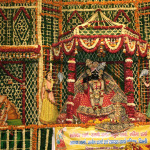
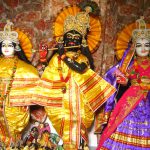
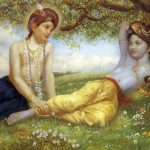
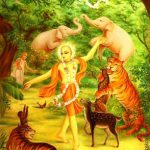
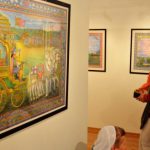


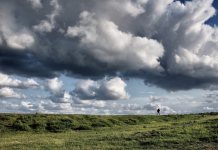
Jaya Srila Gurudeva! Jaya Navadvip Dhama!